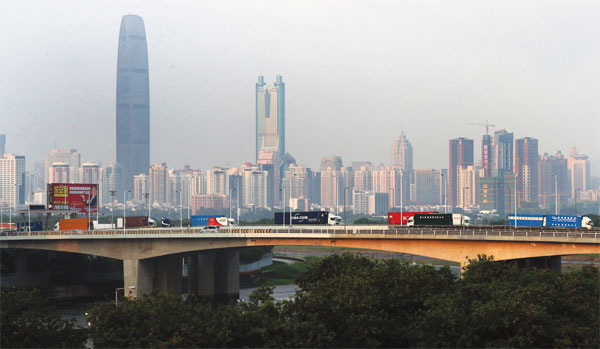Shenzhen East - a hub in the making
Updated: 2016-05-24 07:06
By Zhou Mo in Shenzhen(HK Edition)
|
|||||||
|
A view of Shenzhen. Experts believe Shenzhen's eastern districts, which take up 46.2 percent of the city's total area and contribute 22 percent of the local GDP, have great potential to explore. Edmond Tang / China Daily |
City plans 1.4t yuan business, transportation blueprint to draw industries, talents
Shenzhen is going the extra mile to turn its underdeveloped eastern areas into another startling hub for business and talents, with an ambitious program offering preferential policies, as well as upgraded transportation and public service amenities.
The special economic zone - created in 1980 as the first of the country's five such zones - plans to pour 1.4 trillion yuan ($213.4 billion) into the project, with a total of 10 highways and 14 metro lines to be built over the next five years.
International-class universities and high-tech industrial parks are also being built to create ideal conditions for innovation.
A further 7,000 senior high school places, plus 40,000 university and college slots, will be added to attract 300,000 talents by 2020.
The city's eastern zone, which covers Longgang district, and the new districts of Pingshan and Dapeng, is already home to sprawling residential estates, but has lagged behind its much developed western areas due to poor infrastructure and transportation facilities. It also includes the tourist and industrial belt of Yantian.
"Shenzhen's eastern districts take up 46.2 percent of city's total area, and account for 24 percent of its population. They contribute 22 percent of Shenzhen's gross domestic product," said Shenzhen political adviser Huang Xianfeng.
"The eastern area has great potential to explore."
Lao Changshi, founder of Shenzhen Longer 3D Technology Co Ltd, said a growing number of overseas talents are setting up shop in Longgang, adding that the participation of top international professionals is vital to the development of the eastern districts.
Among young overseas talents who have jumped on the bandwagon is Brian Yang, who has established a company in Longgang. A graduate of Yale University, Yang last year founded Higgs Hub - an incubator group which aims to link startups and entrepreneurs with international resources. Most of the startups in the group are engaged in research and development and the production of smart hardware products.
"Compared with other areas, Longgang has quite a number of high-end manufacturing enterprises, like automaker BYD. They represent the country's strongest manufacturing ability," Yang told China Daily, explaining why he had chosen to settle down in the relatively underdeveloped zone.
Another factor is the area's relatively lower property prices. "Entrepreneurs and innovators will be more willing to settle down in an area where property prices are lower," he said.
Flexible and innovative policies are also needed to attract startups and entrepreneurs to the eastern areas.
A survey among 200 students of the Chinese University of Hong Kong, Shenzhen, shows that 38 percent of them are willing to live and work in the eastern districts, while calling on the government to solve the transportation problem.
"The crucial point in luring talents to the eastern areas is convenient transportation," Yang said.
sally@chinadailyhk.com
(HK Edition 05/24/2016 page9)
